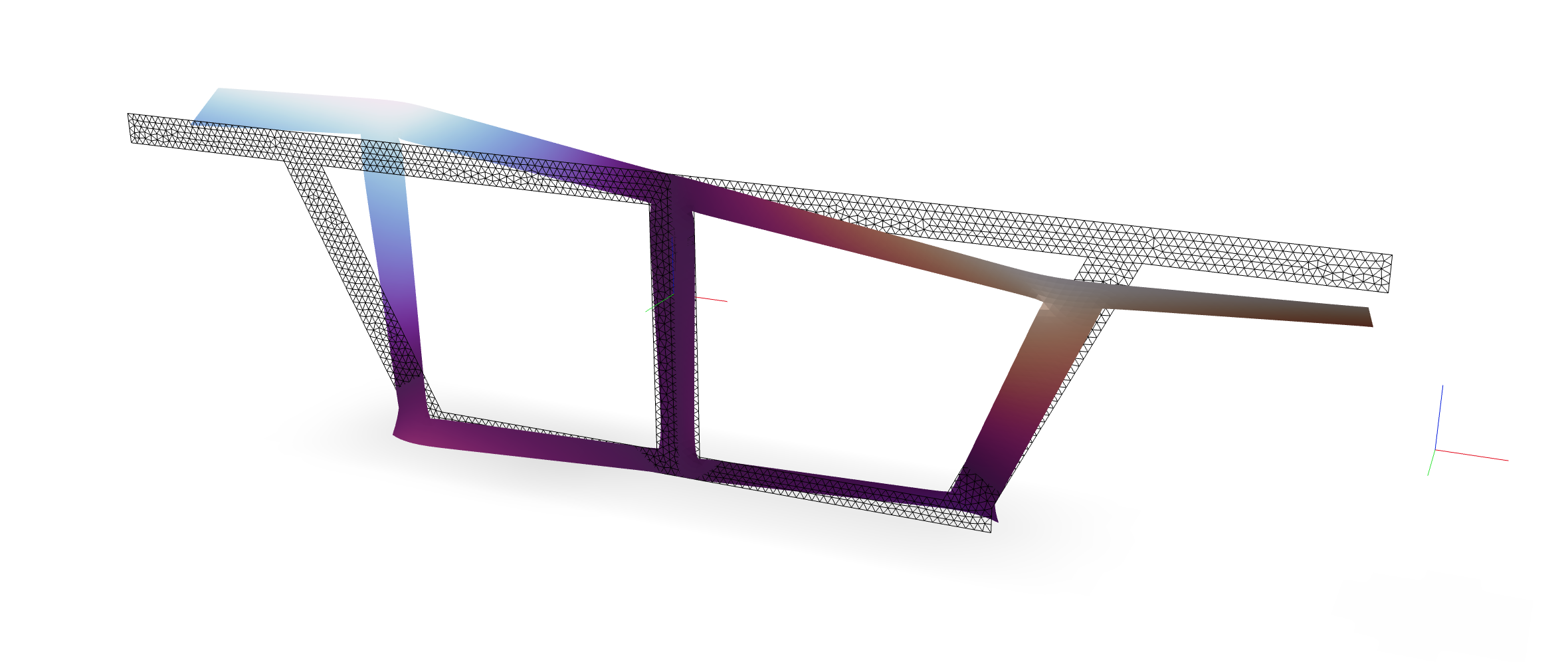Torsion
4 min read • 649 wordsThe Laplace problem is solved for St. Venant's warping function.

Here we consider the St. Venant’s torsion problem. Beginning from the three-dimensional boundary value problem of solid mechanics:
one arrives at a pure Neumann problem of the Laplace operator:
for a given point of rotation .
For this problem, ndm=2 and ndf=1. Rendering is performed with the
veux
library.
import numpy as np
from shps.frame import patch, layer, create_mesh, GeneralSection
def rectangle(b, d):
mesh = create_mesh(mesh_size=t/2.5, patches=[
patch.rect(corners=[[-b/2, -d/2], [b/2, d/2]]),
])
return GeneralSection(mesh, warp_shear=False)
def channel(t, w, h, b):
mesh = create_mesh(mesh_size=min(w,t)/2.5, patches=[
patch.rect(corners=[[0, h/2-t], [b, h/2 ]]),
patch.rect(corners=[[0, -h/2+t], [w, h/2-t]]),
patch.rect(corners=[[0, -h/2 ], [b, -h/2+t]]),
])
return GeneralSection(mesh, warp_shear=False)
def angle(t, b, d):
mesh = create_mesh(mesh_size=t/2.5, patches=[
patch.rect(corners=[[-t/2, -t/2], [b-t/2, t/2]]),
patch.rect(corners=[[-t/2, -d+t/2], [t/2, -t/2]])
])
return GeneralSection(mesh, warp_shear=False)
def wide_flange(d, b, t=None, tw=None, tf=None):
"""
Saritas and Filippou (2009) "Frame Element for Metallic Shear-Yielding Members under Cyclic Loading"
"""
bf = b
if tf is None:
tf = t
else:
t = tf
if tw is None:
tw = tf
yoff = ( d - tf) / 2
zoff = (bf + tw) / 4
# Shear from Saritas and Filippou (2009)
# Ratio of total flange area to web area
alpha = 2*b*tf/d/(2*tw);
# NOTE: This is 1/beta_S where beta_S is Afsin's beta
beta = (1+3*alpha)*(2/3)/((1+2*alpha)**2-2/3*(1+2*alpha)+1/5)
def psi(y, z):
# webs
if abs(y) < (d/2-tf):
return beta*((1+2*alpha) - (2*y/d)**2) - 1 #+ 1
# flange
else:
return 0 # beta*(2*alpha)*(z/b) - 1
mesh = create_mesh([
patch.rect(corners=[[-bf/2, yoff-tf/2],[bf/2, yoff+tf/2]]),# , divs=(nfl, nft), rule=int_typ),
patch.rect(corners=[[-tw/2,-yoff+tf/2],[tw/2, yoff-tf/2]]),# , divs=(nwt, nwl), rule=int_typ),
patch.rect(corners=[[-bf/2,-yoff-tf/2],[bf/2, -yoff+tf/2]]),# , divs=(nfl, nft), rule=int_typ),
], mesh_size=min(tf, tw)/2.5)
return GeneralSection(mesh, warp_shear=psi)
def GirderSection(
thickness_top : float,
thickness_bot : float,
height : float,
width_top : float,
width_webs : list,
web_spacing : float,
web_slope : float = 0.0,
overhang : float = None,
material = None,
):
# ^ y
# |
# _ |_______________________________________________________|
# |_____ _______________ _________ _______________ _____|
# \ \ | | | | / /
# \ \ | | | | | / /
# \ \___________| |_______| |___________/ /
# _ \__________________+__________________/ ---> x
# | |
import opensees.units
spacing = opensees.units.units.spacing
# Dimensions
#------------------------------------------------------
inside_height = height - thickness_bot - thickness_top
# width of bottom flange
if overhang:
width_bot = width_top - \
2*(overhang + web_slope*(inside_height + thickness_bot))
else:
width_bot = web_centers[-1] - web_centers[0] \
+ width_webs[1]/2 + width_webs[0]/2
# number of internal web *spaces*
niws = len(width_webs) - 3
# list of web centerlines?
web_centers = [
-width_bot/2 - inside_height/2*web_slope + 0.5*width_webs[1],
*niws @ spacing(web_spacing, "centered"),
width_bot/2 + inside_height/2*web_slope - 0.5*width_webs[-1]
]
# Build section
#------------------------------------------------------
girder_section = [
# add rectangle patch for top flange
patch.rect(corners=[
[-width_top/2, height - thickness_top],
[+width_top/2, height ]]),
# add rectangle patch for bottom flange
patch.rect(corners=[
[-width_bot/2, 0.0 ],
[+width_bot/2, +thickness_bot]]),
# sloped outer webs
patch.rhom(
height = inside_height,
width = width_webs[0],
slope = -web_slope,
center = [web_centers[0], thickness_bot + inside_height/2]
),
patch.rhom(
height = inside_height,
width = width_webs[-1],
slope = web_slope,
center = [web_centers[-1], thickness_bot + inside_height/2]
)
] + [
patch.rect(corners=[
[loc - width/2, thickness_bot],
[loc + width/2, height - thickness_top]]
)
for width, loc in zip(width_webs[1:-1], web_centers[1:-1])
]
mesh = create_mesh(girder_section, mesh_size=min(thickness_bot, thickness_top, *width_webs)/3.0)
return GeneralSection(mesh, warp_shear=False)
if __name__ == "__main__":
import veux
from veux.plane import PlaneModel
from veux.frame import FrameArtist
from veux.canvas.gltf import GltfLibCanvas
section = wide_flange(d=612, b=229, t=19.6, tw=11.9)
print(section.summary())
from shps.frame.solvers.plastic import PlasticLocus
PlasticLocus(section).plot()#(phi=0.5, ip=5)
import matplotlib.pyplot as plt
plt.show()
artist = FrameArtist(PlaneModel((section.model.nodes, section.model.cells())), canvas=GltfLibCanvas(), ndf=1)
field = section.torsion.warping()
field = {node: value for node, value in enumerate(field)}
artist.draw_surfaces(field = field)
artist.draw_origin()
# R = artist._plot_rotation
# artist.canvas.plot_vectors([R@[*geometry.centroid, 0] for i in range(3)], R.T)
artist.draw_outlines()
veux.serve(artist)